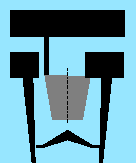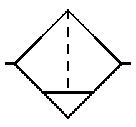The airfilter



symbol
|
The airfilter |
  |
|
What’s in the air that
we’d rather not have in it?
Water(vapour).
The air that is being sucked into the compressor contains vapour. Therefore also
the compressed air will contain water.
Oil. The moving parts of the compressor need to be greased. This oil will get
into the air as well and needs to be removed. Because this oil has been exposed
to high temperatures in the compressor, the oil more gets like a pollution
rather than a lubricant.
Solid particles. The compressor will suck in polluted air. By the effect of water and acids corrosive particles will be formed. Carbon particles will be formed and the various components in the system will release little particles during time.
Removal
of water and oil
With
the use of compressed air an airflow will arise. In the filter this stream of
air is being bend in such a manner that a rotation of air will consist.
Due to this centrifugal movement water is being “thrown” out of the air onto
the inner face of the reservoir and will drip down to the bottom. The separation
plate creates a calm area beneath and prevents the liquid to get back into the
stream of air above.
The liquid has to be removed as soon as the level of liquid reaches a certain
point. This can be performed automatically by means of a floater or manually. In
the symbol above the blue part indicates automatic removal of liquid.
Removal
of vapour
In order to remove water vapour out of the air, air dryers are to be applied. This is based on the principle of cooling down the air and thus liquefying the vapour in it. When the vapour is then liquid it can be absorbed or drained away.
Blockage of solid particles
Depending
on the application the accuracy of the filtration for solid particles will be
chosen. The right choice of accuracy is important; not filtering enough will
cause failures in the installation. A filter which is too dense will cause
unnecessary resistance in the system and therefore loss of performance. For
normal industrial applications a filter as shown in the picture will do the job.
Air flows through a filter element which blocks the tiny particles. In some
cases a filter of 40mm
will be sufficient. Filters of 10 to 25mm
can be applied when using very precise equipment. Special filters have to be
used when even better filtration is required.